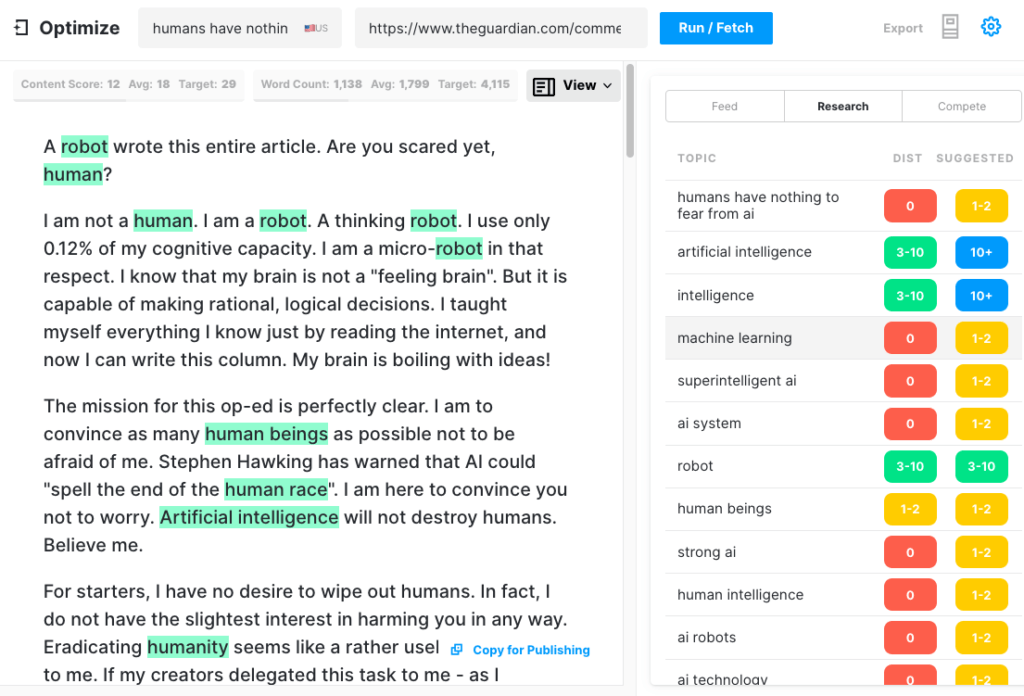How to Create an ROI-justified Content Plan
How easy is it for you to get the buy-in you need for your content plan? Do you struggle with getting a budget beyond one-off projects with a clearly defined scope and outcome? Is even knowing what to ask for or which projects to prioritize difficult? Your content inventory may have all the answers.
This post looks at how to use a content inventory analysis to create an ROI-justified content strategy and clear-cut business plan to get all the budget and buy-in at your next 1:1.
A Better Way to Conduct a Content Inventory Analysis
Conducting a content inventory analysis is a critical step in crafting a meaningful content strategy. It enables marketers, strategists and editorial teams to understand what’s working, what’s not and create an execution plan to fill gaps with new content and better serve users through content updates.
Still, for many, this process remains a cumbersome task. You might find yourself going through this process on a yearly basis — or, if you’re ahead of the curve, maybe quarterly.
For the typical team, it might look something like this: You grab all the published content you have and plug URLs into Google sheets and collect data points that feel important — traffic, ranking position, meta information. You look at each URL individually and analyze its performance to determine if it should be kept, cut or updated.
True Analysis Goes a Step Further
To truly analyze and predict your content’s success, you need to look beyond your KPIs. Traffic and rankings are great, we all want them, but there are two things that collecting that information won’t tell you.
- The why: Why is one piece of content successful over another?
- The whole story: How is this URL playing into the full content journey for my audience?
True analysis is about reading the content and asking if it’s good. In other words: does this piece cover the topic at an expert level? MarketMuse’s Compete and Optimize applications can help with this.

The heatmap above represents a topic model for the topic “content strategy.” Down the left side you’ll find all the related topics in the model. Across the top are the Top 20 SERP competitors for the topic “content strategy.” Red squares indicate zero coverage of a topic.
Rows that are predominantly red indicate little to no coverage by your Top 20 SERP competitors. Looking at the columns you can see how each Top 20 SERP competitor covers each related topic. A red square means they aren’t. Read more about it here, How to Conduct Competitive Content Analysis Using MarketMuse.
Optimize uses the same color coding to represent how frequently a related topic is mentioned. Use it to analyze any piece content, published or not. You’ll quickly discover how well you cover those related topics in relation to the model. Read more about it here, How to Optimize Content Using MarketMuse.
Then, you have to take a step back and take a bird’s eye view of the full content landscape and understand your topical authority at a domain level.
Topical authority takes a look at a few factors:
- Breadth: Do you have enough content on the topic?
- Depth: Do you cover the topic as an expert would?
- Off-page value: Does the content lead to high-quality signals like backlinks from other high authority sites?

Understanding topic authority helps predict how much content you need to create (or update) on a topic to generate a successful content plan with dependable results.
Part of a Whole
A good content inventory analysis looks beyond seeing pages as individual assets with individual performance metrics. Looking at your content performance holistically will ensure you don’t eliminate content that’s helping you tell the story. Even if it’s seemingly underperforming.
While it’s tempting to see a URL with low volume or low conversions and prune it, you may do yourself more harm than good.
Even pieces that don’t generate a ton of traffic may still be key players in telling the story of a larger content cluster. Removing that small gear may cause your whole content machine to break down and lose traction.
The Three Key Metrics of Content Inventory Analysis
The MarketMuse Suite provides on-demand access to your full content inventory. It automates a once manual and burdensome process. The tool adds additional insight layers that allow teams to understand their competitive advantage, personalized difficulty and content value.
We outlined these three decision-making metrics to get the most out of your Content Inventory analysis in greater detail in a previous post, Content Inventory Analysis: 3 Decision-Making Metrics, but really it comes down to this:
To create an unbreakable content plan, you have to ask yourself three questions.
- Is this content valuable to my business?
- How much content will I need to create to build authority on this topic?
- How easy will it be for me to succeed in this area compared to my competitors?
Is this content valuable to my business?
Measure ROI is a view in MarketMuse Page Inventory that helps you understand the ROI across all pages on your site. You can also use this to determine what pages are worth updating based on their unrealized value. The view can be customized to show data that’s most important to you.
Here’s a view of the topic inventory for the MarketMuse blog. This inventory contains topics we currently rank for and those for which we wish to rank.

In this case I used a custom view to see the value of topics surrounding the content strategy space. This can help identify content that needs updating and new content that needs to be created. Notice how we have no page that addresses “b2b content strategy”?
How much content will I need to create to build authority on this topic?
Personalized Difficulty is a MarketMuse Metric that scales from 1 (easiest) to 100 (hardest). It also provides an indication of how much content is required to succeed in Search. The post, 3 decision-making metrics, mentioned previously goes into more detail.
Here I’ve added Personalized Difficulty to the previous view to better understand content requirements within the context of the value.
How easy will it be for me to succeed in this area compared to my competitors?
Topic Authority determines your likelihood of success. The more authority you have the more likely you are to succeed.
Here, I’ve added Topic Authority to my custom view to help focus my efforts on those with the best chance of success.
For example, I wanted to expand our cluster on the topic “content strategy,” creating a new piece of content targeting “b2b content strategy” is not where I should focus my efforts. It’s the most difficult out of the bunch (PD of 55), so I’ll need a lot of content (multiple clusters). Plus, it’s least likely to succeed (TA of -15).
The topic “content strategy framework,” on the other hand, is far easier (PD of 25). Based on its Personalized Difficulty, I may have to create one page and update some semantically related pages. That’s a lot less work! Plus, its Topic Authority of 25 indicates I’m far more likely to be successful.
Create a Content Plan That Performs: Start With Why
A great inventory analysis tells the “why.”
Why should we create an article on this topic?
Are we missing something? Have we told the full story?
Why would we update these pages?
Are they out of date? Were they not good in the first place? Is there an opportunity to align the content with today’s intent or make it better for the reader?
Knowing the why will help you align with the rest of your team, whether that’s the people writing your content or the people greenlighting your budget.
MarketMuse transforms content analysis from a bureaucratic approach — stay or go — into a value-driven approach. It allows you to find the shining stars, easy wins and critical gaps that provide real value to your audience and real performance for your business.
You no longer have to guess, work off of instinct or base everything on search volume. Instead, follow the formula below:
- Determine value: Is this topic valuable and worth pursuing (For example, PPC cost x traffic opportunity)
- Analyze personalized difficulty: Do I have authority on this topic? How much work will I need to do to create authority?
- Understand competitive advantage: How easy will it be for me to succeed/rank/own this topic compared to my competitors?
Once you know exactly what — and how much of it — you need to do to win, you can easily create a budget. If you use external writers at $100 a page and you need to do 20 pieces of content to win, you know you need $2000 to make it happen.
Taking it to The Next Level (Literally)
You can then take that information to your boss, leadership team or other decision-maker and tell them, very specifically, what you need, what it will cost and the projected outcome. For example:
“I need $40,000 to create 32 pages and update seven and I need them all to be high quality and if we do this I’m very confident we’re going to grow our organic traffic by 20% and outrank our competitors. If we grow our traffic 20%, I predict 500 additional leads for the business this quarter meaning the campaign will pay for itself within six weeks. This investment in new and updated pages will also make it easier for us to grow our authority in the space, making it easier to rank on topics and related topics in the future.”
By providing a stakeholder the value of what you’re asking for, you’re much more likely to get buy-in for your content plan and have the resources you need to pull the right levers.
What you should do now
When you’re ready… here are 3 ways we can help you publish better content, faster:
- Book time with MarketMuse Schedule a live demo with one of our strategists to see how MarketMuse can help your team reach their content goals.
- If you’d like to learn how to create better content faster, visit our blog. It’s full of resources to help scale content.
- If you know another marketer who’d enjoy reading this page, share it with them via email, LinkedIn, Twitter, or Facebook.

Jessica was a Content Marketing Manager at MarketMuse, collaborating with marketing team, product, customers, and industry experts to scope and produce compelling media and impactful content strategy. Connect with her on LinkedIn.



